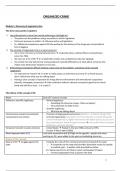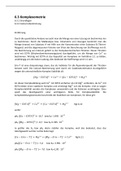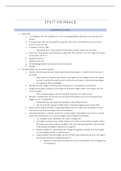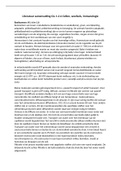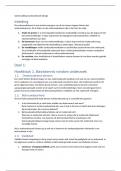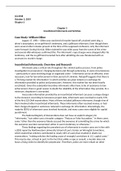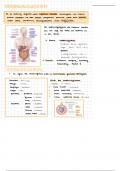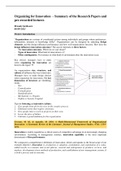Samenvatting Teamwork- Theories, Design and Dynamics
Week 1
- Courtright, S. H., Thurgood, G. R., Stewart, G. L., & Pierotti, A. J. (2015).
- Hackman, J. R. (2002). Why teams don’t work. In Theory and research on small groups.
- Ilgen, D. R., Hollenbeck, J. R., Johnson, M., & Jundt, D. (2005). Teams in organizations: From
Input-Process-Output Models to IMOI Models.
Definition of work teams: independent collection of individuals who share responsibility for specific
outcomes for their organization.
So you have a group of people working in an organization, working towards a common goal, that
people share, and they are interdependent. Interdependence is key in teams. You can have many
different groups that are not teams because they are not interdependent. Interdependence is what
defines the team.
Why are teams so popular?
Teams are everywhere. Organizations are eager to utilize teams because:
- They bring more resources (more people, more resources): man power, expertise,
differences, knowledge.
- Teams bring in more levels of diversity in expertise, background.
- Flexibility, keep the work going. You can have projects that could be done by one person, by
letting multiple people work on it, you have flexibility because no one is available 100% of
the time. Working in a group means you can always keep the project going.
Interdependence is everywhere.
Dictionary definition: The dependence of two or more people or things on eachother.
Interdependence can be lower or it can be higher. Interdependence is a defining feature of the team,
but it can be low. You can have a group of people that are team, but not super dependent on each
other to achieve a common goal. In the literature they make a distinction between three different
types of interdependence. One is lower, intermediate and high in terms of interdependence.
Interdependence in work teams is determined by features of the team that define
interconnectedness of team members.
Pooled: low interdependence. They pool their efforts. Youre put in a group, you have to work on
something, if you just both do your part, and in the end you hand it in and your task is done. There is
interdependence, because you both work towards a common goal together, you have to do a good
, job, but it is low interdependence because there is not a lot of interaction going on, we don’t share
ideas, there is little coordination.
Sequential interdependence: related but slightly different. The first person works on something. Than
this person hands it over to the second person, the second person writes further and improve the
piece. Than the second person hands it in. You can have a long sequence. It is quite common. The
second person is dependent on the second person to do a good job and continue the efforts of the
other.
Reciprocal: high interdependence, this is what you should see in a high tech group, when you create
a complex product. You constantly have to change information and ideas about what you are doing.
The two arrows in the figure are called coordination, because you are coordinating your efforts
together. At some point you combine what you did in one end product. You constantly work
together.
Picture explanation:
- Low: example redundant individual resources and expertise: when you as a group work on
the same thing, are able to do the same thing, that’s called redundant. Without one person,
the other person could still be able to finish the job.
- High: you approach it from different directions because you have different expertise. A
resource can be everything, it could be knowledge or access to fysical resources. This may
differ between team members.
There are two different types of interdependence: task interdependence and output
interdependence.
Task interdependence: degree to which team members depend on each other for resource accesses,
and the extent to which they create workflows that require coordinated action. Over time, as the
team goes on and exists how often do you create workflows that require coordinated action. If
you’re constantly working on something, producing something, where you need the other persons
output on before and if that frequently happens, you have high task interdependence. You are
working on the task as a team member, but the extent to which you can do that successfully, you
need input from other people in the team. Example: medical teams. On the IC with covid, the task
interdependence is low. Simple tasks, turning over the patients. There are different shifts, but an
entire team is responsible for the unit. In complex cancer treatment, the task interdependence is
high. People are coordinating, looking at pictures and checking how the treatment progresses. They
need each other for the patient to get better.
Week 1
- Courtright, S. H., Thurgood, G. R., Stewart, G. L., & Pierotti, A. J. (2015).
- Hackman, J. R. (2002). Why teams don’t work. In Theory and research on small groups.
- Ilgen, D. R., Hollenbeck, J. R., Johnson, M., & Jundt, D. (2005). Teams in organizations: From
Input-Process-Output Models to IMOI Models.
Definition of work teams: independent collection of individuals who share responsibility for specific
outcomes for their organization.
So you have a group of people working in an organization, working towards a common goal, that
people share, and they are interdependent. Interdependence is key in teams. You can have many
different groups that are not teams because they are not interdependent. Interdependence is what
defines the team.
Why are teams so popular?
Teams are everywhere. Organizations are eager to utilize teams because:
- They bring more resources (more people, more resources): man power, expertise,
differences, knowledge.
- Teams bring in more levels of diversity in expertise, background.
- Flexibility, keep the work going. You can have projects that could be done by one person, by
letting multiple people work on it, you have flexibility because no one is available 100% of
the time. Working in a group means you can always keep the project going.
Interdependence is everywhere.
Dictionary definition: The dependence of two or more people or things on eachother.
Interdependence can be lower or it can be higher. Interdependence is a defining feature of the team,
but it can be low. You can have a group of people that are team, but not super dependent on each
other to achieve a common goal. In the literature they make a distinction between three different
types of interdependence. One is lower, intermediate and high in terms of interdependence.
Interdependence in work teams is determined by features of the team that define
interconnectedness of team members.
Pooled: low interdependence. They pool their efforts. Youre put in a group, you have to work on
something, if you just both do your part, and in the end you hand it in and your task is done. There is
interdependence, because you both work towards a common goal together, you have to do a good
, job, but it is low interdependence because there is not a lot of interaction going on, we don’t share
ideas, there is little coordination.
Sequential interdependence: related but slightly different. The first person works on something. Than
this person hands it over to the second person, the second person writes further and improve the
piece. Than the second person hands it in. You can have a long sequence. It is quite common. The
second person is dependent on the second person to do a good job and continue the efforts of the
other.
Reciprocal: high interdependence, this is what you should see in a high tech group, when you create
a complex product. You constantly have to change information and ideas about what you are doing.
The two arrows in the figure are called coordination, because you are coordinating your efforts
together. At some point you combine what you did in one end product. You constantly work
together.
Picture explanation:
- Low: example redundant individual resources and expertise: when you as a group work on
the same thing, are able to do the same thing, that’s called redundant. Without one person,
the other person could still be able to finish the job.
- High: you approach it from different directions because you have different expertise. A
resource can be everything, it could be knowledge or access to fysical resources. This may
differ between team members.
There are two different types of interdependence: task interdependence and output
interdependence.
Task interdependence: degree to which team members depend on each other for resource accesses,
and the extent to which they create workflows that require coordinated action. Over time, as the
team goes on and exists how often do you create workflows that require coordinated action. If
you’re constantly working on something, producing something, where you need the other persons
output on before and if that frequently happens, you have high task interdependence. You are
working on the task as a team member, but the extent to which you can do that successfully, you
need input from other people in the team. Example: medical teams. On the IC with covid, the task
interdependence is low. Simple tasks, turning over the patients. There are different shifts, but an
entire team is responsible for the unit. In complex cancer treatment, the task interdependence is
high. People are coordinating, looking at pictures and checking how the treatment progresses. They
need each other for the patient to get better.

